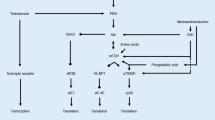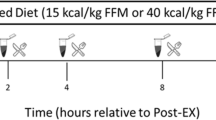Abstract
We aimed to gain insight into the role that the transitory increases in anabolic hormones play in muscle hypertrophy with unilateral resistance training. Ten healthy young male subjects (21.8 ± 0.4 years, 1.78 ± 0.04 m, 75.6 ± 2.9 kg; mean ± SE) engaged in unilateral resistance training for 8 week (3 days/week). Exercises were knee extension and leg press performed at 80–90% of the subject’s single repetition maximum (1RM). Blood samples were collected in the acute period before and after the first training bout and following the last training bout and analyzed for total testosterone, free-testosterone, luteinizing hormone, sex hormone binding globulin, growth hormone, cortisol, and insulin-like growth factor-1. Thigh muscle cross sectional area (CSA) and muscle fibre CSA by biopsy (vastus lateralis) were measured pre- and post-training. Acutely, no changes in systemic hormone concentrations were observed in the 90 min period following exercise and there was no influence of training on these results. Training-induced increases were observed in type IIx and IIa muscle fibre CSA of 22 ± 3 and 13 ± 2% (both P < 0.001). No changes were observed in fibre CSA in the untrained leg (all P > 0.5). Whole muscle CSA increased by 5.4 ± 0.9% in the trained leg (P < 0.001) and remained unchanged in the untrained leg (P = 0.76). Isotonic 1RM increased in the trained leg for leg press and for knee extension (P < 0.001). No changes were seen in the untrained leg. In conclusion, unilateral training induced local muscle hypertrophy only in the exercised limb, which occurred in the absence of changes in systemic hormones that ostensibly play a role in muscle hypertrophy.




Similar content being viewed by others
References
Adams GR (2002) Invited review: autocrine/paracrine IGF-I and skeletal muscle adaptation. J Appl Physiol 93:1159–1167
Ahtiainen JP, Pakarinen A, Alen M, Kraemer WJ, Hakkinen K (2003) Muscle hypertrophy, hormonal adaptations and strength development during strength training in strength-trained and untrained men. Eur J Appl Physiol 89:555–563
Ahtiainen JP, Pakarinen A, Alen M, Kraemer WJ, Hakkinen K (2005) Short vs. long rest period between the sets in hypertrophic resistance training: influence on muscle strength, size, and hormonal adaptations in trained men. J Strength Cond Res 19:572–582
Bhasin S, Storer TW, Berman N, Callegari C, Clevenger B, Phillips J, Bunnell TJ, Tricker R, Shirazi A, Casaburi R (1996) The effects of supraphysiologic doses of testosterone on muscle size and strength in normal men. N Engl J Med 335:1–7
Byrne M, Nieschlag E (2003) Testosterone replacement therapy in male hypogonadism. J Endocrinol Invest 26:481–489
Ferrando AA, Tipton KD, Doyle D, Phillips SM, Cortiella J, Wolfe RR (1998) Testosterone injection stimulates net protein synthesis but not tissue amino acid transport. Am J Physiol 275:E864–E871
Ferrando AA, Sheffield-Moore M, Yeckel CW, Gilkison C, Jiang J, Achacosa A, Lieberman SA, Tipton K, Wolfe RR, Urban RJ (2002) Testosterone administration to older men improves muscle function: molecular and physiological mechanisms. Am J Physiol Endocrinol Metab 282:E601–E607
Friedlander AL, Butterfield GE, Moynihan S, Grillo J, Pollack M, Holloway L, Friedman L, Yesavage J, Matthias D, Lee S, Marcus R, Hoffman AR (2001) One year of insulin-like growth factor I treatment does not affect bone density, body composition, or psychological measures in postmenopausal women. J Clin Endocrinol Metab 86:1496–1503
Hakkinen K, Kallinen M, Linnamo V, Pastinen UM, Newton RU, Kraemer WJ (1996) Neuromuscular adaptations during bilateral versus unilateral strength training in middle-aged and elderly men and women. Acta Physiol Scand 158:77–88
Hakkinen K, Pakarinen A, Newton RU, Kraemer WJ (1998) Acute hormone responses to heavy resistance lower and upper extremity exercise in young versus old men. Eur J Appl Physiol Occup Physiol 77:312–319
Hakkinen K, Pakarinen A, Kraemer WJ, Hakkinen A, Valkeinen H, Alen M (2001) Selective muscle hypertrophy, changes in EMG and force, and serum hormones during strength training in older women. J Appl Physiol 91:569–580
Hansen S, Kvorning T, Kjaer M, Sjogaard G (2001) The effect of short-term strength training on human skeletal muscle: the importance of physiologically elevated hormone levels. Scand J Med Sci Sports 11:347–354
Higbie EJ, Cureton KJ, Warren GL III, Prior BM (1996) Effects of concentric and eccentric training on muscle strength, cross-sectional area, and neural activation. J Appl Physiol 81:2173–2181
Housh DJ, Housh TJ, Johnson GO, Chu WK (1992) Hypertrophic response to unilateral concentric isokinetic resistance training. J Appl Physiol 73:65–70
Hubal MJ, Gordish-Dressman H, Thompson PD, Price TB, Hoffman EP, Angelopoulos TJ, Gordon PM, Moyna NM, Pescatello LS, Visich PS, Zoeller RF, Seip RL, Clarkson PM (2005) Variability in muscle size and strength gain after unilateral resistance training. Med Sci Sports Exerc 37:964–972
Kim PL, Staron RS, Phillips SM (2005) Fasted-state skeletal muscle protein synthesis after resistance exercise is altered with training. J Physiol 568:283–290
Kraemer WJ, Ratamess NA (2005) Hormonal responses and adaptations to resistance exercise and training. Sports Med 35:339–361
Kraemer WJ, Staron RS, Hagerman FC, Hikida RS, Fry AC, Gordon SE, Nindl BC, Gothshalk LA, Volek JS, Marx JO, Newton RU, Hakkinen K (1998) The effects of short-term resistance training on endocrine function in men and women. Eur J Appl Physiol Occup Physiol 78:69–76
Kraemer WJ, Dudley GA, Tesch PA, Gordon SE, Hather BM, Volek JS, Ratamess NA (2001) The influence of muscle action on the acute growth hormone response to resistance exercise and short-term detraining. Growth Horm IGF Res 11:75–83
Lange KH, Andersen JL, Beyer N, Isaksson F, Larsson B, Rasmussen MH, Juul A, Bulow J, Kjaer M (2002) GH administration changes myosin heavy chain isoforms in skeletal muscle but does not augment muscle strength or hypertrophy, either alone or combined with resistance exercise training in healthy elderly men. J Clin Endocrinol Metab 87:513–523
Lee S, Barton ER, Sweeney HL, Farrar RP (2004) Viral expression of insulin-like growth factor-I enhances muscle hypertrophy in resistance-trained rats. J Appl Physiol 96:1097–1104
McCall GE, Byrnes WC, Fleck SJ, Dickinson A, Kraemer WJ (1999) Acute and chronic hormonal responses to resistance training designed to promote muscle hypertrophy. Can J Appl Physiol 24:96–107
McCurdy KW, Langford GA, Doscher MW, Wiley LP, Mallard KG (2005) The effects of short-term unilateral and bilateral lower-body resistance training on measures of strength and power. J Strength Cond Res 19:9–15
Munn J, Herbert RD, Gandevia SC (2004) Contralateral effects of unilateral resistance training: a meta-analysis. J Appl Physiol 96:1861–1866
Munn J, Herbert RD, Hancock MJ, Gandevia SC (2005) Training with unilateral resistance exercise increases contralateral strength. J Appl Physiol 99:1880–1884
Narici MV, Hoppeler H, Kayser B, Landoni L, Claassen H, Gavardi C, Conti M, Cerretelli P (1996) Human quadriceps cross-sectional area, torque and neural activation during 6 months strength training. Acta Physiol Scand 157:175–186
Nindl BC, Kraemer WJ, Hymer WC (2000) Immunofunctional vs immunoreactive growth hormone responses after resistance exercise in men and women. Growth Horm IGF Res 10:99–103
Nindl BC, Kraemer WJ, Marx JO, Arciero PJ, Dohi K, Kellogg MD, Loomis GA (2001) Overnight responses of the circulating IGF-I system after acute, heavy-resistance exercise. J Appl Physiol 90:1319–1326
Phillips SM (2004) Protein requirements and supplementation in strength sports. Nutrition 20:689–695
Phillips SM, Green HJ, Tarnopolsky MA, Grant SM (1995) Increased clearance of lactate after short-term training in men. J Appl Physiol 79:1862–1869
Phillips SM, Hartman JW, Wilkinson SB (2005) Dietary protein to support anabolism with resistance exercise in young men. J Am Coll Nutr 24:134S–139S
Raastad T, Glomsheller T, Bjoro T, Hallen J (2001) Changes in human skeletal muscle contractility and hormone status during 2 weeks of heavy strength training. Eur J Appl Physiol 84:54–63
Raastad T, Glomsheller T, Bjoro T, Hallen J (2003) Recovery of skeletal muscle contractility and hormonal responses to strength exercise after two weeks of high-volume strength training. Scand J Med Sci Sports 13:159–168
Rennie MJ (2003) Claims for the anabolic effects of growth hormone: a case of the emperor’s new clothes? Br J Sports Med 37:100–105
Rennie MJ, Tipton KD (2000) Protein and amino acid metabolism during and after exercise and the effects of nutrition. Annu Rev Nutr 20:457–483
Rennie MJ, Wackerhage H, Spangenburg EE, Booth FW (2004) Control of the size of the human muscle mass. Annu Rev Physiol 66:799–828
Shepstone TN, Tang JE, Dallaire S, Schuenke MD, Staron RS, Phillips SM (2005) Short-term high- vs. low-velocity isokinetic lengthening training results in greater hypertrophy of the elbow flexors in young men. J Appl Physiol 98:1768–1776
Sinha-Hikim I, Artaza J, Woodhouse L, Gonzalez-Cadavid N, Singh AB, Lee MI, Storer TW, Casaburi R, Shen R, Bhasin S (2002) Testosterone-induced increase in muscle size in healthy young men is associated with muscle fiber hypertrophy. Am J Physiol Endocrinol Metab 283:E154–E164
Sinha-Hikim I, Roth SM, Lee MI, Bhasin S (2003a) Testosterone-induced muscle hypertrophy is associated with an increase in satellite cell number in healthy, young men. Am J Physiol Endocrinol Metab 285:E197–E205
Sinha-Hikim I, Roth SM, Lee MI, Bhasin S (2003b) Testosterone-induced muscle hypertrophy is associated with an increase in satellite cell number in healthy, young men. Am J Physiol Endocrinol Metab 285:E197–E205
Staron RS, Malicky ES, Leonardi MJ, Falkel JE, Hagerman FC, Dudley GA (1989) Muscle hypertrophy and fast fiber type conversions in heavy resistance-trained women. Eur J Appl Physiol Occup Physiol 60:71–79
Staron RS, Karapondo DL, Kraemer WJ, Fry AC, Gordon SE, Falkel JE, Hagerman FC, Hikida RS (1994) Skeletal muscle adaptations during early phase of heavy-resistance training in men and women. J Appl Physiol 76:1247–1255
Stewart BG, Tarnopolsky MA, Hicks AL, McCartney N, Mahoney DJ, Staron RS, Phillips SM (2004) Treadmill training-induced adaptations in muscle phenotype in persons with incomplete spinal cord injury. Muscle Nerve 30:61–68
Tarnopolsky MA, Phillips SM, Varbanov G, Demuth A, Stevens J, Qu A, Wang A, Isfort RJ (2006) The transcriptome expression pattern in skeletal muscle is similar between legs: implications for study design using microarrays. Physiol Genomics
Williamson DL, Gallagher PM, Carroll CC, Raue U, Trappe SW (2001) Reduction in hybrid single muscle fiber proportions with resistance training in humans. J Appl Physiol 91:1955–1961
Yasuda N, Glover EI, Phillips SM, Isfort RJ, Tarnopolsky MA (2005) Sex-based differences in skeletal muscle function and morphology with short-term limb immobilization. J Appl Physiol 99:1085–1092
Acknowledgments
This work was supported by the National Science and Engineering Research Council of Canada. SBW is a Canadian Institutes of Health Research (CIHR) Canada Graduate Scholarship holder. SMP and MAT are Premier’s Research Excellence Award (ON) holders and acknowledge that funding. SMP is a CIHR New Investigator award recipient.
Author information
Authors and Affiliations
Corresponding author
Rights and permissions
About this article
Cite this article
Wilkinson, S.B., Tarnopolsky, M.A., Grant, E.J. et al. Hypertrophy with unilateral resistance exercise occurs without increases in endogenous anabolic hormone concentration. Eur J Appl Physiol 98, 546–555 (2006). https://doi.org/10.1007/s00421-006-0300-z
Accepted:
Published:
Issue Date:
DOI: https://doi.org/10.1007/s00421-006-0300-z




